The next-gen MacBook Pro with Retina Display Review
by Anand Lal Shimpi on June 23, 2012 4:14 AM EST- Posted in
- Mac
- Apple
- MacBook Pro
- Laptops
- Notebooks
Last year when I wrote about the new MacBook Airs I offered two forward looking paragraphs:
What happens from here on out is what's really interesting. Intel has already committed to moving the TDP of its mainstream parts from 35W - 45W down to 10 - 20W. Since the Air is the new mainstream Mac notebook, Apple has already made that move. The performance in this 10 - 20W segment is going to get much better over the next two years, particularly once Haswell arrives.
The Thunderbolt Display is the first sign of what's to come. Moving IO controllers and expansion into the display, and potentially even moving discrete GPUs out of the notebook are all in store for us. Apple is really ahead of the curve here, but it's easy to imagine a future where laptops become a lot more like the new Air and shift to a couple high bandwidth ports instead of numerous lower bandwidth connections.
Perhaps I was being too aggressive in the prediction of a couple of high bandwidth ports. After all, the next-generation MacBook Pro with Retina Display features four such IO ports (2 x Thunderbolt and 2 x USB 3.0). But you get my point. Gigabit Ethernet and Firewire 800 are both gone. The discrete GPU is still present but I suspect even its days are numbered, at least inside the chassis. The personal computer as we knew it for so long, is changing.
The personal computer is getting thinner, lighter, more integrated and more appliance-like. The movement is no longer confined to just Apple either. The traditional PC OEMs are following suit. Even Microsoft has finally entered the PC hardware business, something it threatened to do for years but hadn't until now. Distribution models will change, the lines between different form factors will continue to blur. What was once a mature industry is going through a significant transformation. It’s exciting but at the same time it makes me uneasy. When I first got into this industry everyone had stories of companies with great ideas that just didn’t make it. As we go through this revolution in computing I’m beginning to see, first hand, the very same.
Apple makes the bulk of its revenue from devices that don’t look like traditional personal computers. For the past couple of years I’ve been worried that it would wake up and decide the traditional Mac is a burden, and it should instead be in the business of strictly selling consumer devices. With its announcements two weeks ago in San Francisco, I can happily say that my fears haven’t come true. At least not yet.
It’s been a while since Apple did a really exciting MacBook Pro launch. Much to my surprise, even the move to Sandy Bridge, the first quad-core in a MacBook Pro, was done without even whispers of a press conference. Apple threw up the new products on its online store, shipped inventory to its retail outlets, updated the website and called it a day. Every iPhone and iPad announcement however was accompanied with much fanfare. The MacBook Pro seemed almost forgotten.
With its WWDC unveil however Apple took something that it had resigned to unexciting, dare I say uncool status, and made a huge deal about it. Two weeks ago Apple did the expected and offered relatively modest upgrades to all of its portable Macs, all while introducing something bold.
Apple calls it the MacBook Pro with Retina Display. You’ll see me refer to it as the next-gen MacBook Pro, Retina MacBook Pro, rMBP or some other permutation of these words.
After using it for the past two weeks I can honestly say it’s the best Mac Apple has ever built. And there’s a lot more to it than hardware.
Portability
If you were hoping for a 15-inch MacBook Air, that’s not what the rMBP is. Instead it is a far more portable 15-inch MacBook Pro. I have to admit I was a bit let down the first time I laid eyes on the next-gen MacBook Pro, it looks good but it doesn’t look all that different. The disappointment quickly faded as I actually picked up the machine and started carrying it around. It’s not ultra light, but man does it make the previous chassis feel dated.
While I never really liked lugging around the old MBP (and it always made me feel like the old fogey at tradeshows where everyone else had something 13-inches or smaller), carrying the rMBP is a pleasure by comparison. Pictures really don’t do it justice. The impressively thin display assembly or overall chassis thickness look neat in a photo but it’s not until you actually live with the rMBP that you can appreciate what Apple has done here. I carry around a 15-inch MacBook Pro because it’s my desktop, and as such it’s incredibly useful to have with me when I travel. For my personal usage model, the Retina MacBook Pro is perfect.
If your workload demands that you need the performance of a MacBook Pro and your lifestyle requires you to carry it around a lot, the reduction in thickness and weight alone will be worth the upgrade to the rMBP. If you spend most of your time stationary however, you’ll have to be sold on the display and internal characteristics alone. The bad news is if the design doesn’t get you, everything else will.

From left to right: 11-inch MacBook Air, 13-inch MacBook Air, 15-inch MacBook Pro, MacBook Pro with Retina Display
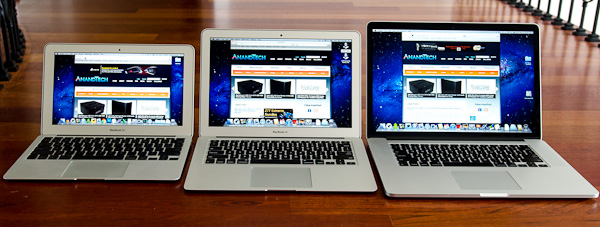
From left to right: 11-inch MacBook Air, 13-inch MacBook Air, MacBook Pro with Retina Display
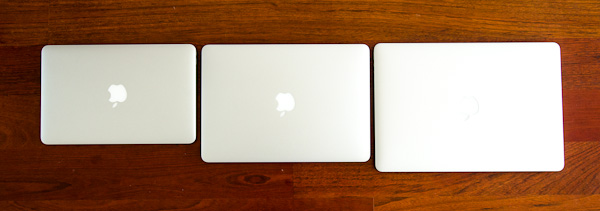
From left to right: 11-inch MacBook Air, 13-inch MacBook Air, MacBook Pro with Retina Display


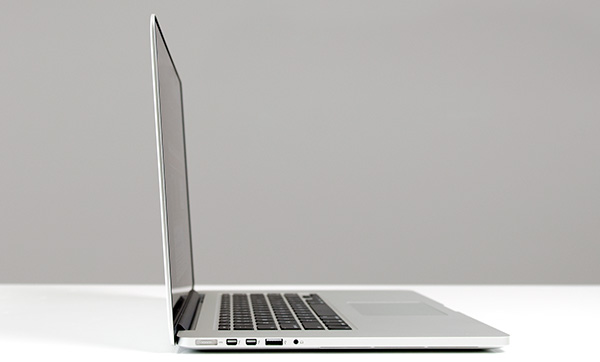
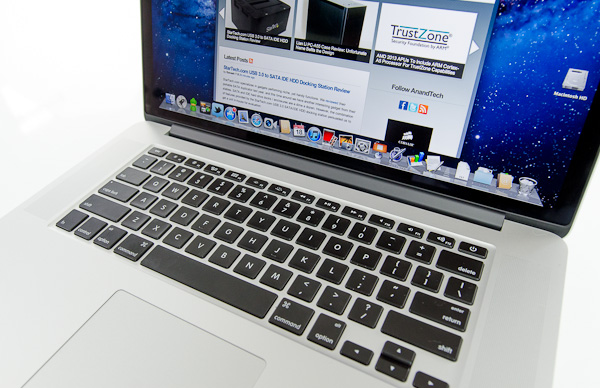
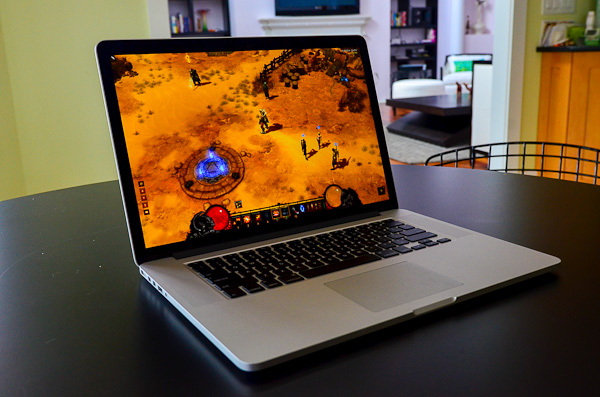
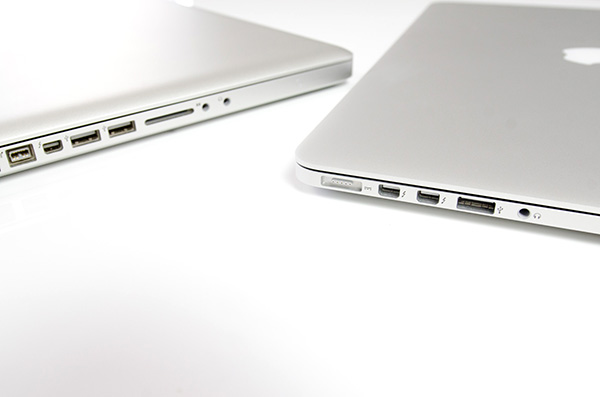
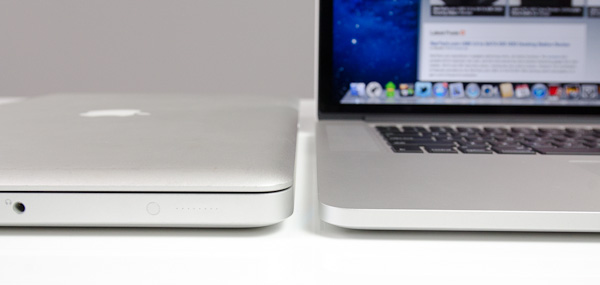








471 Comments
View All Comments
Manni01 - Tuesday, July 17, 2012 - link
Great review as usual, but I would really like to know how Anand was able to check if Speedstep and Turboboost worked. In the last Macbook review (2011), he used MSR Tools, but I could not get these to work on Lion on my June 2012 MBP 13. He remains very vague about how, although he does confirm this works as expected on the MBP 15r .This isn't my experience. I tried using Intel's MacCPUID in Lion, and a few other tools, and it looks like the CPU is locked at nominal speed (2.9GHz in my case), so neither speedstep nor Turboboost seem to work in Lion. They work as intended in Win7/Bootcamp, going down to 1GHz to save battery or up to 3.6GHz when only one core needs more power.
So here are my questions:
1) Anand please could you tell us which tools you have used?
2) Has anyone tested this on the new macs (June 2012), using which tools, and what is the result?
Speedstep definitely worked in Snow Leopard on my MBP 13 2011, so it must be a limitation in Lion.
kenancagri - Thursday, July 19, 2012 - link
It is very good article. I loved it. Thanks for Lal Shimpi.williamsj - Friday, July 27, 2012 - link
Even the iPhone 4 is physically easier to maintain/upgrade than this thing.Check http://www.ifixit.com
The worst maintainable piece of hardware they have ever looked at!!
John
Throckmorton - Tuesday, August 7, 2012 - link
You didn't address whether pixel doubling is supported for games. IE rendering each pixel as 4 screen pixels. That's very different from upscaling, because with pixel doubling there's no blurring.Dubious1968 - Thursday, August 9, 2012 - link
I've given up waiting for Apple to refresh the iMac, and am thinking of buying the Macbook Pro Retina instead. My only concern is that Apple should have equipped this laptop with a more powerful graphics card, given it is driving such a high res screen.I will be using it for Photoshop and HD video editing along with some gaming.
Any help appreciated.
Dubious
sleddoggin - Saturday, August 11, 2012 - link
So, I've done my best to read (skim) through all 46 pages of comments for this post, and have been reading other threads on more-or-less the same topic, so forgive me if I've missed something.I own a base model rMBP w/ 16mb ram (for safety), and am really quite unimpressed by openGL performance in games that were fluid (30-60fps ANYway) on my old Mac Pro 2006 w/ an ATI Radeon 5770 HD graphics card (I guess it helps, too, that the Mac Pro GPU is sitting in an x16 PCIe lane, not an x8, as with the rMBP). The Mountain Lion upgrade has been some improvement.
When I first read Anandtech's article, I sort of thought, why not shut the lid on my MacBook Pro Retina, and plug in my old Apple Cinema display when I want to play games (I plan on using my desktop display when I'm at home for most stuff anyway). Then, the discreet NVIDIA GeForce GT 650M wouldn't be overworked by having to render all those extra pixels, right? Wrong. Gauging from the tests I've done, anyway, I'm getting the same choked performance on my relatively low-res external display (with the rMBP lid shut) as I do when I play those games on the rMBP screen (either at native OR scaled resolutions).
So my question becomes, isn't this a software issue? Shouldn't the Apple/NVIDIA engineers be able to re-route ALL of that sexy mobile GPU processing power to a single, lower-res external display, and save us gamers the hassle of trading in our rMBPs for regular 2012 MBPs?
This computer upgrade is really a no-brainer for me, otherwise. With the Thunderbolt ports, and the built in HDMI, I've been easily able to retire my old Mac Pro, and still keep my various displays (HDTV, etc.), and extensive array of USB/Firewire accessories fully operational. It just blows my mind that I get better gaming performance from my creaky old 2006 Mac Pro.
Thanks for reading my contribution to this thread. Does my thought hold ANY water? I sure as heck don't want to give up this beautiful-looking piece of hardware if I don't have to...
Cheers,
-SledDoggin' (another reluctant Apple fanboy)
vml_ - Saturday, August 25, 2012 - link
Here's what I don't get and haven't seen answered anywhere. If there are performance issues at 1800p, can they be alleviated by downscaling (eg to 1080p)?S J - Friday, August 31, 2012 - link
That sounds like great. good effort. Also have seen nice article on http://techinlead.com/apple-introducing-macbook-pr...LookupOEM - Saturday, September 22, 2012 - link
maybe i'm wrong, but i always thought that OEM means "Original Equipment Manufacturer", a company that makes equipement that is sold by others under their own name.Toshiba making hard drives for Apple makes it an OEM, just as Intel, Samsung and others
but, Apple IS NOT AN OEM, and there is no such thing as a PC OEM !!
a PC OEM would be a company that supplies parts to build a PC, not the PC maker itself.
did i miss something here ?
Penzi - Thursday, October 4, 2012 - link
Now that Mountain Lion has been out for a bit and several programs have been "retinized" are you planning on updating your review or crafting a mini-review that addresses changes, improvements and new caveats? I, for one, would love to hear about scrolling performance and resolution impact to common software (the OS and iWorks, FinalCut, etc), such as setting the display to "more space" (1920) and clocking the Safari FB news feed, and so on...